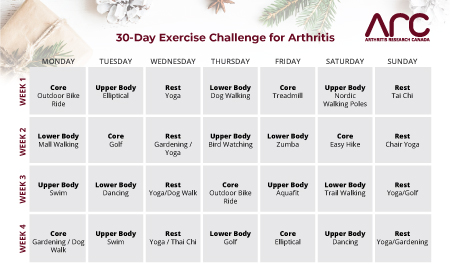30-Day Exercise Challenge for Arthritis
30 days of motion is lotion for your joints!
 Regular exercise is an integral part of your overall health, and especially important for those living with arthritis. However, finding the best exercises that work for your body and daily routine can feel overwhelming. This is especially true for novice exercisers dealing with joint pain and fatigue.
Regular exercise is an integral part of your overall health, and especially important for those living with arthritis. However, finding the best exercises that work for your body and daily routine can feel overwhelming. This is especially true for novice exercisers dealing with joint pain and fatigue.
Arthritis Research Canada’s Senior Scientist, Dr. Linda Li, and Research Trainee, Dr. Jasmin Ma, have teamed up with the Arthritis Patient Advisory Board (APAB), to bring you a 30-day exercise challenge to help motivate and keep your joints moving this winter and beyond! The best prescription is the one you will do, and we are right there with you to provide the support you need to stay active and healthy!
Step one: Identify the best strength training program (2-3 times a week)
Arthritis Exercise Equipment you can use but not needed:
- Resistance Bands
If gripping is painful or not possible, tie the resistance bands to soft fabric such as wristbands or hair bands.
- Dumbbells, Kettlebell, Ankle or Wrist Weights
Don’t have any of the above equipment? Even cans of soup or dish soap jugs work!
Dr. Jasmin Ma’s best bang for your buck exercises
Lower Body Exercises
● Squats (with or without chair)
● Lunges
Core Exercises
● Planking – We recommend elbow plank rather than full or side plank to reduce load on wrist joints.
● Dead Bug
● Pallof Press
Upper Body Exercises
● Dumbbell Floor Press
● Seated Row with Resistance Bands
● Side Raises and Front Raises
● Bicep curl to shoulder press with weights
If you’re new to exercise, even doing these exercises once a week is a great start. As you get stronger and more comfortable, aim to do 6 to 12 exercises, 2 to 3 times a week. It is recommended you have 48 hours of rest before repeating exercises that use the same muscle group.
You can do anywhere from 1-3 sets per workout with a standard of 8-12 repetitions per set. On a scale of one to ten, aim for at least six or a seven level of intensity, in other words, how hard you’re working. In general, your muscles should feel worked at the end of your set, making your last 1-2 reps challenging to complete. If you feel it is too easy, then add extra reps or increase the weight.
Pro-tip: Watch out for joint pain! Muscle discomfort with strength training is common, however people with arthritis should pay extra attention to their joints when performing an exercise.
Please seek the help of a qualified exercise professional for any questions about technique or modifications.
Step two: Identify as many forms of endurance you enjoy (4-5 times a week)
Identify your daily step goal and the number of days you plan to be active. You can incorporate some fun into your fitness and spice it up with some variety. Here is a list of physical activity ideas, pick your favourite and try something new. Do at least 30 minutes a day, 3-5 times a week. You can even break up your activity throughout the day, every minute counts!
- Nordic Walking Poles
- Mall Walking – Best Before Mall Opening Hours
- Outdoor Bike Ride
- Dog Walking
- Yoga or Chair Yoga
- Zumba
- Aquafit or Swimming
- Exercise Videos for Pilates or Zumba
- Pilates
- Golf
- Gardening
- Trail Walking
- At Home Exercise Machines (eg. Stationary Bike, Elliptical or Treadmill)
- Tai Chi
- Snowshoeing
- Virtual Reality Machine or Exercise Games with a Video Game System
- Mini Exercise Bike Pedal for Legs and Arms
- Exercise Steps or At-home Stairs Workout
- Dancing
- Rebounder
- Qi Gong
An important reminder from Dr. Li, “there is no one-size-fits-all solution but it is reasonable to aim for 5,000 to 6,000 steps, which can be accumulated during household activities on rest days, and 6,000 to10,000 steps per day when adding in daily exercises.“
Step three – Rest is just as important as exercise
Rest days are incredibly important as it allows your body to recover. Remember to plan for one to two days of rest to alleviate stress on your body and balance fatigue.
“There is no shame in having one or two days a week where you don’t leave the house and don’t get out of your pajamas, it’s a form of self-care! However, I do always make it a point to stretch and walk around my apartment on the days I consider a rest day. Also, don’t give yourself a hard time when you’ve planned a long hike and don’t feel up for it. Arthritis is unpredictable and it’s okay to switch things up from time to time,” says, Eileen Davidson, Arthritis Patient Advisory Board (APAB) member living with rheumatoid arthritis.
Step four: Print out our 30-day exercise challenge
Download and print PDF versions of our 30-day exercise challenge for arthritis. The more specific the plan, the more likely you’ll commit to it.
Track your activity and symptoms and sign-up for OPERAS
OPERAS (On-demand Program to EmpoweR Active Self-management) is an easy to use web/mobile app designed for people with rheumatoid arthritis to track their health. This app helps people to “see” how their symptoms and physical activity levels change over time, together with the treatment they use. Become motivated and help advance arthritis research while doing it, join today!
Looking for additional at-home exercises for Arthritis? See our latest At-Home Exercise Guide
- Home Arthritis Exercise Equipment for Cardio and Muscle Strengthening
- Tips from one of our Patient Advisory Board members on living with Arthritis
Arthritis At-Home Exercise Guide
Video Recommendations
Arthritis Consumer Experts – Arthritis At Home Series
- Arthritis At Home Ep.10: How to stay active and exercise at home during COVID-19 with Dr. Linda Li.






















































